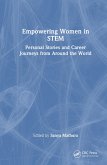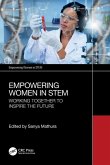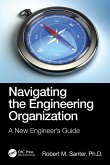- Broschiertes Buch
- Merkliste
- Auf die Merkliste
- Bewerten Bewerten
- Teilen
- Produkt teilen
- Produkterinnerung
- Produkterinnerung
The book compares and links training and learning methods used within engineering fields for new engineers to the low retention rate of female engineers and the higher percentage of women in medical fields. It discusses the adoption of a Lean Development Training and Learning approach which is currently being successfully used in the medical field.
Andere Kunden interessierten sich auch für
![Empowering Women in STEM Empowering Women in STEM]() Empowering Women in STEM35,99 €
Empowering Women in STEM35,99 €![Empowering Women in STEM Empowering Women in STEM]() Empowering Women in STEM84,99 €
Empowering Women in STEM84,99 €![Empowering Women in STEM Empowering Women in STEM]() Empowering Women in STEM33,99 €
Empowering Women in STEM33,99 €![Navigating the Engineering Organization Navigating the Engineering Organization]() Robert M. Santer (TheSanterGroup)Navigating the Engineering Organization53,99 €
Robert M. Santer (TheSanterGroup)Navigating the Engineering Organization53,99 €![The Engineering of Foundations, Slopes and Retaining Structures The Engineering of Foundations, Slopes and Retaining Structures]() Rodrigo SalgadoThe Engineering of Foundations, Slopes and Retaining Structures75,99 €
Rodrigo SalgadoThe Engineering of Foundations, Slopes and Retaining Structures75,99 €![Always Making Progress Always Making Progress]() Ian MaddenAlways Making Progress133,99 €
Ian MaddenAlways Making Progress133,99 €![Systems Engineering Systems Engineering]() Adedeji B. Badiru (Dean Graduate School of Engineering a ProfessorSystems Engineering103,99 €
Adedeji B. Badiru (Dean Graduate School of Engineering a ProfessorSystems Engineering103,99 €-
-
-
The book compares and links training and learning methods used within engineering fields for new engineers to the low retention rate of female engineers and the higher percentage of women in medical fields. It discusses the adoption of a Lean Development Training and Learning approach which is currently being successfully used in the medical field.
Produktdetails
- Produktdetails
- Women of STEM
- Verlag: Taylor & Francis Ltd
- Seitenzahl: 226
- Erscheinungstermin: 22. November 2022
- Englisch
- Abmessung: 155mm x 233mm x 21mm
- Gewicht: 412g
- ISBN-13: 9781032071855
- ISBN-10: 1032071850
- Artikelnr.: 64358860
- Women of STEM
- Verlag: Taylor & Francis Ltd
- Seitenzahl: 226
- Erscheinungstermin: 22. November 2022
- Englisch
- Abmessung: 155mm x 233mm x 21mm
- Gewicht: 412g
- ISBN-13: 9781032071855
- ISBN-10: 1032071850
- Artikelnr.: 64358860
Robert N. Stavig, Brush Prairie, WA During his 35 year career with Hewlett-Packard, Bob spent the last twenty years in Product Research and Development in various management and technical roles, where he utilized the principles and methods of Lean Development in the delivery of nearly a dozen areas of work within product programs, process development, and technical asset development. In addition, Bob has fifteen years of experience in the areas of: manufacturing development, factory support, factory operational management, and worldwide manufacturing leadership. Bob has a degree in Mechanical Engineering from Washington State University and is certified as a Six Sigma Black Belt through American Society of Quality. Bob has a certification in Lean Development from University of Michigan and is a Certified Scrum Master. Alissa R. Stavig, MD, Billings, MT Alissa received her Doctor of Medicine from Duke University School of Medicine, Durham, NC in 2017. In 2022 she graduated with a combined five-year residency program in Internal Medicine and Psychiatry, from Duke University School of Medicine in Durham, NC. Alissa's training includes clinical experiences in inpatient and outpatient settings in both disciplines as well as educational experiences in advocacy, interdisciplinary and integrated healthcare, quality improvement, and medical education. During her training in residency, she experienced the benefit of developing clinical and leadership skills through a system with graduated responsibility which included leading clinical teams of medical students and first year residents.
Part I: The Problem 1. The Female Engineer Retention Challenge 2. Two Sides
of the Same Coin - Gender Bias and Gender Confidence 3. It Begins with Pink
and Blue Part II: Analyzing the Problem Using an Engineering Process 4.
Medicine as a Model for Engineering - Creating Job Satisfaction 5. Through
the Lens of an Engineer 6. Finding Root Cause Through a Causal Diagram
Part III: Developing a Solution: Lean as a Foundation for Change and
Learning 7. Industry Efficiency Via Lean 8. Creating a Physician - the
Learning Process 9. An Engineer's Learning Environment Part IV: Strategy 1:
Empowering Control of a Career 10. Building a Level Playing Field 11. It's
Just Good Engineering - The Basics of Lean Development 12. Accepting a Hand
Up: Role Models, Technical Coaches, and Mentors Part V: Strategy 2:
Enabling Leaders to Lead - Creating Satisfying Work 13. Lead the Change to
the Way the Work is Done 14. Leading the Development of Engineers and
Managers 15. Leading Beyond the Causal Diagram Appendix A. Going Home On
Time - Lean Development - The Principles Appendix B. Bringing Lean
Development to a University Engineering Program. Appendix C. Books to
Consider
of the Same Coin - Gender Bias and Gender Confidence 3. It Begins with Pink
and Blue Part II: Analyzing the Problem Using an Engineering Process 4.
Medicine as a Model for Engineering - Creating Job Satisfaction 5. Through
the Lens of an Engineer 6. Finding Root Cause Through a Causal Diagram
Part III: Developing a Solution: Lean as a Foundation for Change and
Learning 7. Industry Efficiency Via Lean 8. Creating a Physician - the
Learning Process 9. An Engineer's Learning Environment Part IV: Strategy 1:
Empowering Control of a Career 10. Building a Level Playing Field 11. It's
Just Good Engineering - The Basics of Lean Development 12. Accepting a Hand
Up: Role Models, Technical Coaches, and Mentors Part V: Strategy 2:
Enabling Leaders to Lead - Creating Satisfying Work 13. Lead the Change to
the Way the Work is Done 14. Leading the Development of Engineers and
Managers 15. Leading Beyond the Causal Diagram Appendix A. Going Home On
Time - Lean Development - The Principles Appendix B. Bringing Lean
Development to a University Engineering Program. Appendix C. Books to
Consider
Part I: The Problem 1. The Female Engineer Retention Challenge 2. Two Sides
of the Same Coin - Gender Bias and Gender Confidence 3. It Begins with Pink
and Blue Part II: Analyzing the Problem Using an Engineering Process 4.
Medicine as a Model for Engineering - Creating Job Satisfaction 5. Through
the Lens of an Engineer 6. Finding Root Cause Through a Causal Diagram
Part III: Developing a Solution: Lean as a Foundation for Change and
Learning 7. Industry Efficiency Via Lean 8. Creating a Physician - the
Learning Process 9. An Engineer's Learning Environment Part IV: Strategy 1:
Empowering Control of a Career 10. Building a Level Playing Field 11. It's
Just Good Engineering - The Basics of Lean Development 12. Accepting a Hand
Up: Role Models, Technical Coaches, and Mentors Part V: Strategy 2:
Enabling Leaders to Lead - Creating Satisfying Work 13. Lead the Change to
the Way the Work is Done 14. Leading the Development of Engineers and
Managers 15. Leading Beyond the Causal Diagram Appendix A. Going Home On
Time - Lean Development - The Principles Appendix B. Bringing Lean
Development to a University Engineering Program. Appendix C. Books to
Consider
of the Same Coin - Gender Bias and Gender Confidence 3. It Begins with Pink
and Blue Part II: Analyzing the Problem Using an Engineering Process 4.
Medicine as a Model for Engineering - Creating Job Satisfaction 5. Through
the Lens of an Engineer 6. Finding Root Cause Through a Causal Diagram
Part III: Developing a Solution: Lean as a Foundation for Change and
Learning 7. Industry Efficiency Via Lean 8. Creating a Physician - the
Learning Process 9. An Engineer's Learning Environment Part IV: Strategy 1:
Empowering Control of a Career 10. Building a Level Playing Field 11. It's
Just Good Engineering - The Basics of Lean Development 12. Accepting a Hand
Up: Role Models, Technical Coaches, and Mentors Part V: Strategy 2:
Enabling Leaders to Lead - Creating Satisfying Work 13. Lead the Change to
the Way the Work is Done 14. Leading the Development of Engineers and
Managers 15. Leading Beyond the Causal Diagram Appendix A. Going Home On
Time - Lean Development - The Principles Appendix B. Bringing Lean
Development to a University Engineering Program. Appendix C. Books to
Consider








